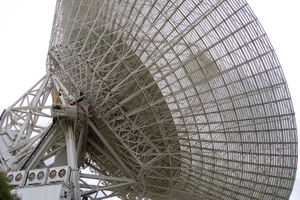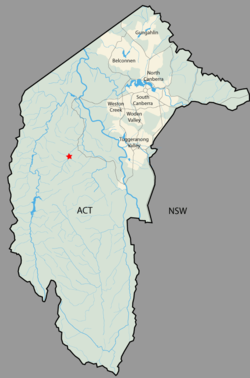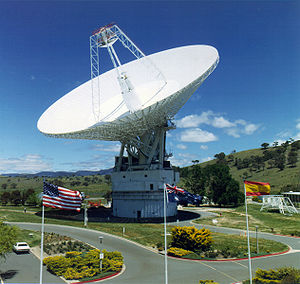
Canberra Deep Space Communication Complex
Encyclopedia
.jpg)

Australia
Australia , officially the Commonwealth of Australia, is a country in the Southern Hemisphere comprising the mainland of the Australian continent, the island of Tasmania, and numerous smaller islands in the Indian and Pacific Oceans. It is the world's sixth-largest country by total area...
at Tidbinbilla in the Paddys River (a tributory of the Cotter River) valley, about half an hour's drive out of Canberra
Canberra
Canberra is the capital city of Australia. With a population of over 345,000, it is Australia's largest inland city and the eighth-largest city overall. The city is located at the northern end of the Australian Capital Territory , south-west of Sydney, and north-east of Melbourne...
in the Australian Capital Territory
Australian Capital Territory
The Australian Capital Territory, often abbreviated ACT, is the capital territory of the Commonwealth of Australia and is the smallest self-governing internal territory...
. The complex is part of the Deep Space Network
Deep Space Network
The Deep Space Network, or DSN, is a world-wide network of large antennas and communication facilities that supports interplanetary spacecraft missions. It also performs radio and radar astronomy observations for the exploration of the solar system and the universe, and supports selected...
run by NASA
NASA
The National Aeronautics and Space Administration is the agency of the United States government that is responsible for the nation's civilian space program and for aeronautics and aerospace research...
's Jet Propulsion Laboratory (JPL)
Jet Propulsion Laboratory
Jet Propulsion Laboratory is a federally funded research and development center and NASA field center located in the San Gabriel Valley area of Los Angeles County, California, United States. The facility is headquartered in the city of Pasadena on the border of La Cañada Flintridge and Pasadena...
. It is commonly referred to as the Tidbinbilla Deep Space Tracking Station and was officially opened on 19 March 1965 by the then Prime Minister of Australia
Prime Minister of Australia
The Prime Minister of the Commonwealth of Australia is the highest minister of the Crown, leader of the Cabinet and Head of Her Majesty's Australian Government, holding office on commission from the Governor-General of Australia. The office of Prime Minister is, in practice, the most powerful...
Sir Robert Menzies
Robert Menzies
Sir Robert Gordon Menzies, , Australian politician, was the 12th and longest-serving Prime Minister of Australia....
.
The station is separated from Canberra by the Murrumbidgee River, but most notably by the Coolamon Ridge and Urambi Hills, but mainly by Bullen Range, that help shield the city's radio frequency
Radio frequency
Radio frequency is a rate of oscillation in the range of about 3 kHz to 300 GHz, which corresponds to the frequency of radio waves, and the alternating currents which carry radio signals...
(RF) noise from the dishes. Located nearby is the Tidbinbilla Nature Reserve
Tidbinbilla Nature Reserve
Tidbinbilla Nature Reserve, on the fringe of Namadgi National Park, is a short drive from the city of Canberra, Australia. The reserve covers an area of approximately 54.50 km² and consists of a large valley floor, the Tidbinbilla Mountain and the Gibraltar range...
.
The CSIRO manages most of NASA's activities in Australia.
In February 2010 CSIRO took over direct management of the site with the establishment of CASS (CSIRO Astronomy and Space Science). Previous to this CDSCC had been managed by external sub-contractor organisations, such as Raytheon
Raytheon
Raytheon Company is a major American defense contractor and industrial corporation with core manufacturing concentrations in weapons and military and commercial electronics. It was previously involved in corporate and special-mission aircraft until early 2007...
Australia from 2003-2010.
The complex is one of just three in the world. The other two are the Madrid Deep Space Communication Complex
Madrid Deep Space Communication Complex
The Madrid Deep Space Communications Complex is a ground station located in Robledo de Chavela, Spain, and operated by Ingenieria y Servicios Aeroespaciales, S.A. for Instituto Nacional de Técnica Aeroespacial.-Deep Space Network:...
located in Spain
Spain
Spain , officially the Kingdom of Spain languages]] under the European Charter for Regional or Minority Languages. In each of these, Spain's official name is as follows:;;;;;;), is a country and member state of the European Union located in southwestern Europe on the Iberian Peninsula...
and the Goldstone Deep Space Communications Complex
Goldstone Deep Space Communications Complex
The Goldstone Deep Space Communications Complex — commonly called the Goldstone Observatory — is located in California's Mojave Desert. Operated by ITT Corporation for the Jet Propulsion Laboratory, its main purpose is to track and communicate with space missions. It includes the Pioneer...
in the United States
United States
The United States of America is a federal constitutional republic comprising fifty states and a federal district...
.
History

- The Tidbinbilla Tracking Station (now known as CDSCC) was opened in 1965 and is the only NASA tracking station in Australia still in operation. During the ApolloProject ApolloThe Apollo program was the spaceflight effort carried out by the United States' National Aeronautics and Space Administration , that landed the first humans on Earth's Moon. Conceived during the Presidency of Dwight D. Eisenhower, Apollo began in earnest after President John F...
program, Tidbinbilla was used for tracking the Apollo Lunar ModuleApollo Lunar ModuleThe Apollo Lunar Module was the lander portion of the Apollo spacecraft built for the US Apollo program by Grumman to carry a crew of two from lunar orbit to the surface and back...
.
- The Orroral Valley Tracking StationOrroral Valley Tracking StationThe Orroral Valley tracking station supported Earth-orbiting satellites, as part of NASA's Spacecraft Tracking and Data Acquisition Network . It is located approximately 50 kilometres south of Canberra, Australian Capital Territory...
was opened in May 1965 in what is now part of Namadgi National ParkNamadgi National ParkNamadgi National Park is located in the southwestern part of the Australian Capital Territory, bordering Kosciuszko National Park in New South Wales. It lies approximately 40 km southwest of Canberra, and makes up approximately 46% of the ACT's land area....
. Its role was orbiting satellite support, although it also supported the Apollo-Soyuz Test ProjectApollo-Soyuz Test Project-Backup crew:-Crew notes:Jack Swigert had originally been assigned as the command module pilot for the ASTP prime crew, but prior to the official announcement he was removed as punishment for his involvement in the Apollo 15 postage stamp scandal.-Soyuz crew:...
in 1975. It was closed in 1985.
- Honeysuckle Creek Tracking StationHoneysuckle Creek Tracking StationHoneysuckle Creek was a NASA tracking station near Canberra, Australia, which played an important role in supporting Project Apollo. The station was opened in 1967 and closed in 1981....
opened in 1967 and was built primarily to support the Apollo moon missions, mainly communications with the Apollo Command Module. After the cancellation of the Apollo Project the station supported SkylabSkylabSkylab was a space station launched and operated by NASA, the space agency of the United States. Skylab orbited the Earth from 1973 to 1979, and included a workshop, a solar observatory, and other systems. It was launched unmanned by a modified Saturn V rocket, with a mass of...
until its re-entry in 1979 when the station joined the Deep Space NetworkDeep Space NetworkThe Deep Space Network, or DSN, is a world-wide network of large antennas and communication facilities that supports interplanetary spacecraft missions. It also performs radio and radar astronomy observations for the exploration of the solar system and the universe, and supports selected...
in support of the Viking and Voyager projects. 1981 saw the closure of the station and its 26 m antenna was moved to CDSCC to become known as Deep Space Station 46. After the antenna was removed the rest of the facility was dismantled and knocked down. Its foundation, access road and parking area are all that remains of the facility
Receivers

New South Wales
New South Wales is a state of :Australia, located in the east of the country. It is bordered by Queensland, Victoria and South Australia to the north, south and west respectively. To the east, the state is bordered by the Tasman Sea, which forms part of the Pacific Ocean. New South Wales...
at busy times to receive data from spacecraft
Spacecraft
A spacecraft or spaceship is a craft or machine designed for spaceflight. Spacecraft are used for a variety of purposes, including communications, earth observation, meteorology, navigation, planetary exploration and transportation of humans and cargo....
. There are plans to build up to three additional 34 m beam waveguide antenna
Beam waveguide antenna
A beam waveguide antenna is a specific variety of parabolic dish that sends the transmitted or received signal from a stationary transmitter or receiver to a movable dish by means of a beam waveguide. With a conventional parabolic antenna, the transmitter or receiver is mounted at the focus, and...
s by 2015.
The first of these will be DSS-35 with preliminary construction having begun in July 2010.
- DSS-34 is a 34 m beam waveguide antennaBeam waveguide antennaA beam waveguide antenna is a specific variety of parabolic dish that sends the transmitted or received signal from a stationary transmitter or receiver to a movable dish by means of a beam waveguide. With a conventional parabolic antenna, the transmitter or receiver is mounted at the focus, and...
, which uses a system of radio frequency mirrors to place the receiving and transmitting hardware underground rather than on top of the dish. It is the most recent antenna at CDSCC, being built in 1997. - DSS-43 is a 70 m dish originally constructed as a 64 m in 1973 and enlarged in 1987. It is the largest steerable parabolic antennaParabolic antennaA parabolic antenna is an antenna that uses a parabolic reflector, a curved surface with the cross-sectional shape of a parabola, to direct the radio waves. The most common form is shaped like a dish and is popularly called a dish antenna or parabolic dish...
in the Southern HemisphereSouthern HemisphereThe Southern Hemisphere is the part of Earth that lies south of the equator. The word hemisphere literally means 'half ball' or "half sphere"...
. - DSS-45 is a 34 m dish built in 1986.
- DSS-46 is a 26 m dish. It was moved in 1984 from Honeysuckle Creek, where it was built in 1967. It was decommissioned in late 2009. In May 2010 the AIAA (American Institute of Aeronautics and Astronautics) declared the antenna a Historical Aerospace Site.
- DSS-49 is the designation of the 64 m dish at Parkes.
The station's collimation
Collimated light
Collimated light is light whose rays are parallel, and therefore will spread slowly as it propagates. The word is related to "collinear" and implies light that does not disperse with distance , or that will disperse minimally...
tower is located approximately 3 km to the north-west, on Black Hill.
See also
- Carnarvon Tracking StationCarnarvon Tracking StationThe Carnarvon Tracking Station in Western Australia was a tracking station built in 1963 for use by NASA for the Gemini program, the second step for NASA's plan to put a human on the Moon...
- OTC Satellite Earth Station CarnarvonOTC Satellite Earth Station CarnarvonThe OTC Satellite Earth Station Carnarvon was established to meet the need for more reliable and higher quality communications for NASA's Apollo Moon project...
- Parkes Tracking station in NSW

